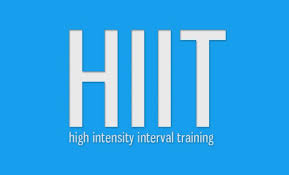The concept of High Intensity Interval Training (HIIT) isn’t altogether new, but this workout style is getting a lot of buzz lately, and for good reason. HIIT topped the American College of Sports Medicine’s recent list of the top fitness trends for 2014, and it’s popularity continues to grow. Studies on the benefits of incorporating HIIT into your workout regimen abound. Read on to learn more about what HIIT is, why it’s effective and how you can start making it part of your fitness plan.
What is HIIT?
HIIT is a style of workout that alternates short bursts of high-energy exertion with short periods of recovery or rest. HIIT workouts are typically short in duration (30 minutes or less), but promise fat and calorie burning benefits that last long after you step out of the gym. Popular examples of HIIT workouts are P90X and Crossfit, but you needn’t buy a DVD or sign up for a new gym to reap the benefits. There is no specific formula for creating a HIIT workout, and the length of these intervals and the exercise performed during them can vary widely. HIIT workouts can be done on the treadmill, with plyometric exercise or with weights, so they don’t just apply to cardio. Check out the Greatist infographic at the end of this post for a great overview of HIIT, it’s benefits and it’s variations.
Why does it work?
The basic principle is that, by alternating between high and low intensity, you’re able to optimize the amount of time you spend at maximum exertion. According to Leonard Kaminsky, Exercise Physiologist at Ball State University, HIIT utilizes the stress-response principle, stimulating your body to respond to being pushed to its maximum capacity. “It’s something that occurs naturally in athletics, but as we get older, it often gets lost in our daily fitness regimens,” says Kaminsky. “The goal is to stimulate the body in a different way than it’s used to, and force it to adapt.” The result? You burn more energy in a shorter amount of time, and increase your metabolic rate, thus seeing continued energy burning results throughout the day. Often referred to as “afterburn” this effect is also described as Excess Post Exercise Oxygen Consumption. Essentially, when you force you push your body to its maximum capacity, it has to work harder to replenish its oxygen supply, even after you have completed your workout. So, not only can you burn more calories in a shorter amount of time, but the calorie burning effects continue throughout the day.
Why Try HIIT?
Aside from maximizing calorie burn, there are a variety of other benefits that make this such an in demand workout:
- Boost metabolism– As discussed above, the afterburn effects of HIIT mean that your body burns more energy doing everyday activities. While the effects for a single day are minimal, the result of an increased metabolism add up over time, helping to maintain a healthy weight.
- Save Time – research continues to show that HIIT produces similar benefits to steady pace, moderate intensity continuous workouts in a fraction of the time. As an article in the Journal of Physiology points out, this is big news as lack of time continues to be one of the biggest reasons cited for lack of regular exercise.
- Increase Endurance – While you’re workouts may be shorter, a study published in the Journal of Philology showed that subjects completing 8 weeks of HIIT training were able to cycle twice as long at the same pace vs. their ability prior to the study. This is good news for people training for endurance races or just looking to improve their cardiovascular health!
- Convenience – HIIT can be done with no equipment and almost anywhere. So whether you’re traveling or simply don’t have time to get to the gym, no more excuses! You can adapt the concept of HIIT to any space. Try the Body Weight Remix workout for a quick, do anywhere burn.
- Improve Cardiovascular Health – Research continues to show that HIIT is more beneficial and effective in improving cardiovascular fitness than continuous moderate intensity exercise. In a British Journal of Sports Medicine article, Weston, et. al found that, among the benefits of HIIT are increased Vo2 Max (a measure of aerobic fitness), decreased blood pressure, and increased cardiac function. On top of these physiological benefits, they also found that people who perform HIIT exercise report higher quality of life and more enjoyment of exercise. ()
How to get started
If you’re new to exercise, ease your way into HIIT training to avoid injury. Focus on good form, and work your way up to harder and harder high intensity bursts as you find establish your limits. Try HIIT 101 Treadmill Intervals or Total Body Tabata to get started. For those who already exercise regularly, HIIT is extremely versatile, and can be introduced to your fitness regimen by adding a few new HIIT workouts each week, or by modifying your existing workouts to incorporate intervals (ie. Instead of running 30 minutes at a steady pace, try alternating between high and low speeds each minute). HIIT can be applied to traditional cardio like the treadmill or bike, or to your lifting. Just use caution when introducing it to a new exercise, and always remember to warm-up and focus on your form first and foremost.
More Health and Fitness News & Tips at Greatist.


